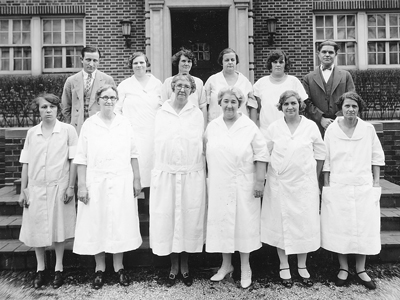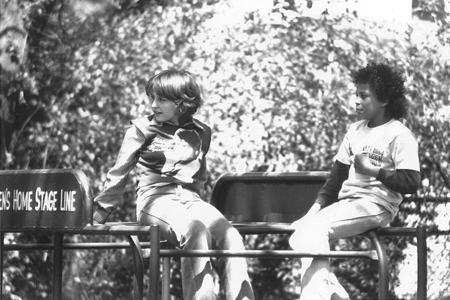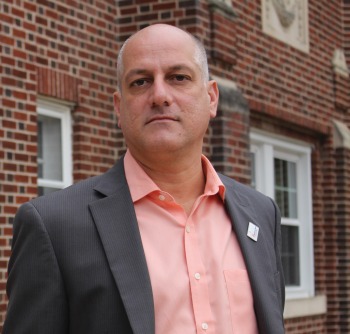For 150 years, Children’s Home has given underserved kids a childhood… and a future.
“How many kids don’t have parents? How many kids have parents who shouldn’t be parents? How many kids are abused, and how many kids are not wanted?” The Children’s Home Association of Illinois serves all of them, explains Matt George, CEO. “What’s amazing is how much over the years that demand has grown. It’s sad.”
When it first opened as the Christian Home Mission in 1866, Children’s Home focused on the needs of the poor in Peoria, with an industrial school to teach young girls sewing skills and a “Home for the Friendless” providing shelter to women and children. Merging with the Women’s Christian Association in 1875, the organization also focused on district visiting, assisting area families in need of groceries, clothing or rent money. Renamed the Children’s Home in 1935, it has relocated some half a dozen times, its services swelling with the increased demands of a growing community.
Over the years, Children’s Home has morphed often, becoming what it has needed to be in order to survive… and serve. Today, its community-based, family-focused programming accompanies a wide range of services including foster care and adoption, residential care, behavioral health services, supervised independent living, an academy for autism, a special education school, crisis intervention, homeless services, in-home counseling and more. Amidst an oft-tumultuous industry, this diversity has been the organization’s formula for survival.
“We’re in the ‘saving kids’ lives’ business,” George declares. “That’s a big responsibility, and we don’t take it lightly.”
Big Kid in Town
Now operating from six locations with a staff of more than 450 professionals, Children’s Home supports some 1,700 children each month on its $25-million budget, making it the largest social service agency in Peoria. “Our goal is to become the premier agency in the state—and the United States,” says George. “If we’re able to grow, we’re able to help more kids. If you don’t have that mentality, then you’re probably in the wrong business.”
You might call George a master of community collaboration. With an extensive career in nonprofit fundraising and management, he took on the role of Children’s Home CEO in 2014, though he’s been knee-deep in the organization since 2004, when he became president and CEO of Youth Farm. Three years later, George worked with area leaders to merge the two like-minded organizations. Then in 2011, he did it again, merging the Cancer Center for Healthy Living with the Hult Center for Health Education, where he served as the combined organization’s executive director. Not only did the union prompt annual savings of $80,000, it streamlined local mental health and senior programming. Still looking for similar collaborative initiatives, George says he’s steering Children’s Home toward the emerging model of coordination of care—what he calls “the community piece.”

The newest programs at Children’s Home aim to team up with other groups around town to better serve the community, he says. For instance, the organization now has full-time counselors at select District 150 schools to address the social, emotional and health needs of students within the educational setting. Similarly, the Community Trauma Team, with support from the United Way, serves as a crisis intervention program for everything from tornado devastation and suicide contemplation to workplace injuries and community violence.
“Is there a stray from the mission? Somewhat,” George admits. “But it is about the community and making sure everybody understands that it is our job in times of need to be there to help. And that is what we stick by.”
It all plays nicely with the organization’s vision: a healthy community where families and children come first. But that vision has been challenged in recent years, as declining funding threatens to wreak havoc on a human services field that’s already difficult to navigate.
“What we do and how we get paid is data-driven,” George notes. But gauging success is a subjective matter in a field where every child’s case is its own mission, with singular metrics for success. In one case, success could mean helping a teen graduate high school and become a productive citizen; for another, success might mean just being able to write. “It may take six years to get him to that point, but if that’s the goal, then that’s a success,” he explains.
“Our staff does a great job catering a treatment plan to each individual. But that takes time, and it’s hard,” he adds, noting how Children’s Home employees are cross-trained for multiple platforms. For instance, certified teachers can be effective at both the Youth Farm or at Kiefer School, and counselors can move around the organization’s many behavioral health programs. This flexibility allows for stronger curricula, but also helps with retention. And as community needs shift, the organization can shift its resources accordingly.
In addition, the strategy helps avoid compassion fatigue, the psychological residue that comes from working with those suffering the consequences of traumatic events, and emotional burnout, which is notoriously high in the social service sector. “Some of the kids have really difficult emotional issues,” explains Ken Snodgrass, a prominent local attorney who has volunteered for more than a decade in various capacities for Children’s Home and Youth Farm. “It takes special people to do that—and it’s a really good thing that Peoria has those special people.”

The Business of Diversification
“You hear the term, especially in hospitals,” says George. “Care coordination. That’s what this business is becoming. It means being able to take in a referral [and] know that this child may need behavioral health services, they may need Kiefer School, they may need Youth Farm—and to be able to have everybody be on the same page, to do what’s best for each child.” This mentality, he explains, is crucial to the group’s future success.
While there are many organizations similar to Children’s Home, none have lasted as long. Snodgrass has witnessed its endurance firsthand; he chaired the Youth Farm board during the 2007 merger. “It seemed to be a good fit for Children’s Home at that time… and provided additional strength to help diversify [services],” he says. Youth Farm now houses the organization’s Residential Treatment program and Group Homes for kids. Meanwhile, less diversified organizations “have been dramatically challenged to continue on with their mission,” he adds.
Through programming diversification, Children’s Home has braced itself for storms, George says; if one branch is struck by lightning, the tree still stands. “But I also look at this time as an opportunity to help each other more—to be able to put down the walls, reach across the street and help the other agencies.”
Getting the Word Out
“This is a very passionate community,” George stresses. “There’s not a lot of communities like ours… from a fundraising and corporate standpoint, and looking at all the board members and volunteers—not just for us, but all the area nonprofits.” That being said, providing services in a stagnant economy has not been easy, and with growing demands, many Children’s Home services now have a waiting list, he says. What’s more, there’s often a disconnect between the available services and individuals in need.
“I know one alley we could go to right now… There’s probably 10 or 12 people in that alley, and some of them are kids. You don’t just go there and say, ‘Hey, we have a program,’” he explains, outlining the referral system by which Children’s Home receives its clients. “It doesn’t matter if you’re running cancer programs or afterschool programs. If you don’t know it’s there, and you don’t have a cell phone, or you don’t have a home or don’t have food, how are you calling 2-1-1, or how are you getting help? That’s why we need to get the word out.”
 To that end, one of George’s primary goals is to raise awareness by sharing the stories he hears daily—some of which haunt him. Like the 17-year-old girl who showed up to Children’s Home pregnant and homeless with a four-year-old, three-year-old and two-year-old in tow. Or the boy who was arrested 24 times by the age of 14.
To that end, one of George’s primary goals is to raise awareness by sharing the stories he hears daily—some of which haunt him. Like the 17-year-old girl who showed up to Children’s Home pregnant and homeless with a four-year-old, three-year-old and two-year-old in tow. Or the boy who was arrested 24 times by the age of 14.
“You would think this kid has no chance at becoming a regular adult someday. How could you even get a job? Except when you peel back why he was arrested that many times: 23 of the 24 arrests were for stealing food for his brothers and sisters because he was homeless,” he explains. “I can tell that story, [and] people sit there, and they’re shocked. People don’t know what’s underneath their noses in this community…” He pauses, his voice trailing off. “There’s just story after story after story that will put you in tears.”
Saving Our Future Today
With a century and a half of community impact already, it’s Matt George’s goal for Children’s Home to be around for another 150 years. “It’s my obligation to set the table for the next person to come in and take the reins,” he explains. “And to sustain a business, you have to be the best, or you’re not going to stay in business.”
You’d think that would equate to a lot of stress, but George doesn’t see it that way. “It’s really no different from any other job. The pressure is in seeing the kids struggle. Seeing a kid who’s been beat up by a family member, or who’s been sexually abused—that’s pressure. Going out and asking for $20,000 to fund the programs is not pressure,” he says with a smile.
One such program, Leaders of Tomorrow, is designed to provide at-risk students with support services to help them succeed. “Right now, there are 19 high school kids [in the program] who are going to graduate, and they will be the first in their families to graduate from high school. That is something to brag about!” he exclaims. “When you take all the kids under our care and have them be successful—or at least give them the opportunity to be successful—that defines success, and it makes the community stronger. They’re our future.”
Without Children’s Home, a lot of underserved kids would find themselves in trouble, Snodgrass adds, sighing heavily at the thought. “Without Children’s Home, the school districts would be challenged… There’d be fewer alternatives for families dealing with autistic children. [Without] the programs we provide for kids to become functioning, responsible, tax-paying adults, we’d lose a great opportunity to save kids.” And that’s no exaggeration.
A few months ago, during a standard audit at Children’s Home, a young client approached the auditor with concern. “Are you here to do something with our program?” George recalls the boy asking. The auditor explained why he was there. “Okay, I just wanted to make sure you know how good this guy is,” the boy said, pointing to his counselor. “He was the dad I never had, and if I didn’t have him, I’d be dead.” iBi


